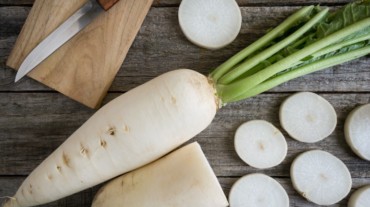
From salads to parathas, radish is a hot favourite vegetable in Indian households, especially in the winter season. While we love noshing on this crisp, white veggie with a piquant flavour, we often tend to chuck its leaves away. But what you may not know is that even its leaves are full of flavour and fabulous benefits.
No wonder then when you put radish and radish leaves together in a recipe, what you get is a dish which is high on the taste and health quotient. But what is this recipe? Come, let us tell you how to make ‘Mooli ki bhurji’. It is quite a winter staple in Punjabi households, and tastes best when eaten with piping hot phulkas or parathas!

Ingredients:
Recipe:

Our grannies and moms have always pressed on the health benefits of radish, but come, let’s get some expert advice. Nutritionist Kavita Devgan has shared some wholesome information around the nutritional benefits of this superfood in her book Fix it with Food by Kavita Devgan.
The expert says that this slightly bitter root is amazingly low in calories (100 gm of radish gives less than 20 calories), is loaded with vitamin C, and is rich in folate, Vitamin B6, riboflavin, thiamin and minerals like iron, magnesium and copper.
Here’s a book excerpt about why radish is great:
Radish is high in roughage, contains a lot of water, and is low on the glycemic index too (keeps blood sugar stable), so it is a great food even for those who are watching their weight or sugar levels.
This veggie is a great source of anthocyanins, a type of antioxidant that is great for our heart and displays anti-cancer and anti-inflammatory properties. In fact, the folic acid, vitamin C and anthocyanins in radish make it a very effective cancer-fighting food.
Eating radish regularly keeps cholesterol levels in check, and the potassium in it keeps blood pressure low.
Select Topics of your interest and let us customize your feed.
PERSONALISE NOWIt is fabulous for winter months as it naturally decreases the congestion of the respiratory system, cuts the irritation of the nose, throat and windpipe, and decongests the lungs — symptoms that accompany frequent colds, infections, allergies and other causes common during these months.
So, a mooli parantha or salad when in season, is undoubtedly a no-brainer to keep winter ailments in check!

According to the expert, the leaves are even more nutrient-dense than the radish. They deliver lots of iron, which helps cut fatigue, prevent anaemia and boost the haemoglobin level. They are a good source of vitamin C (as much as six times more per serving than the radish itself), which boosts immunity big time and delivers some vitamin A, thiamine (vitamin B1), pyridoxin (vitamin B6), folic acid (vitamin B9), calcium and the hard-to-find phosphorous.
In fact, the high level of potassium, iron, vitamin C and dietary fabric found in radish greens help strengthen the heart and keep our cholesterol levels sorted.
They also have anti-ageing properties, beat bloating, and prevent constipation. All in all, it’s great for the gut, and for your overall well-being!
When are you making this mooli ki bhurji then?